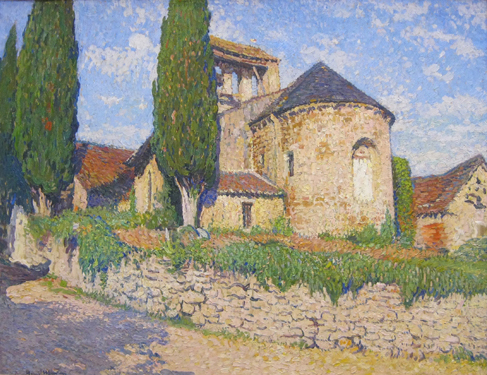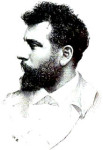
Henri-Jean-Guillaume Martin
French, 1860-1943
The Bastide of Anglass Guillac, 1926 ca.
oil on canvas
32 x 42 ¼ in.
SBMA, Gift of Mrs. Harriet Maxwell
1981.31

Undated photograph of Martin
“If only I dared, if only I could embrace nature, oh, it is she who is our model of beauty.” - Henri Martin
RESEARCH PAPER
The Museum’s oil on canvas "The Bastide of Anglass Guillac", painted around 1926, is an excellent example of Henri Martin’s mature style and his favorite subject matter, a magnificent day in the French countryside. The title refers to the fortressed towns that were built in the south of France during the middle ages. The painting faithfully depicts a cluster of heavy stone buildings of varying heights surrounded by a lush garden, spilling over an old stonewall. The weight of the buildings is balanced by three tall trees in bloom on the left side of the canvas. The scene perfectly captures Martin’s love of the harmonious relationship between man and nature. A geometric framework of cones, cylinders, rectangles, and sweeping arcs creates the overlapping architecture, and provides the structure of the painting. Although substantial, the buildings visually compete with the vivid blue sky
The paint is applied in a thick impasto, creating a highly textured mosaic appearance. Martin used brushstrokes of differing lengths, which produce various effects from the relative smoothness of the slate roof to the rough appearance of the crumbling wall. If the painting is viewed from a distance, the individual brushstrokes remain visible; yet still create a vibrating feeling of light and atmosphere.
Depicting a warm sunny day, the light shines brightly on the façades of the buildings on the right in contrast to the dappled light of the shaded road on the left of the composition. The limestone appears to bake in the mid-day sun. Martin used a palette of bold pure colors, enhancing the oranges and purples of the slanted roofs, the vivid greens of the garden, and the warm browns and yellows of the stonework. The sky is dotted with clouds, created with diagonal, irregular dabs of white paint, which gives the impression that the sky is in a constant state of movement and change.
The son of a cabinetmaker and an Italian mother, Post-Impressionist painter Henri Martin was born in Toulouse, France in 1860. He studied art at the Toulouse School of Fine Arts, focusing on a traditional academic curriculum. When he was nineteen, he moved to Paris to work in the studio of academic painter Jean-Paul Laurens. Martin always retained elements of his early training, and never fully broke away. He experienced early success in his career, highlighted by a scholarship to study in Italy. The fresco paintings of Giotto and Masaccio along with the breathtaking light of the Italian countryside had a lasting influence on Martin’s work. Away from the constraints of the Paris Salon, he was able to develop his own style, which blended academic training, particularly composition, with recent innovative contemporary approaches to brushwork. After returning to Paris in 1889, he began painting landscapes with a pointillist-style brushstroke and a repetition of geometric shapes inspired by Neo-Impressionists like Georges Seurat. In the 1890s, Martin added imaginary themes to his work, aligning himself with the Symbolist movement for a time.
The year 1900 was a transformative time in Henri Martin’s life and work. Realizing his dream, Martin purchased a large 17th century house overlooking the village of La Bastide-du-Vert in southwestern France. His country home, Marquayrol, became a treasured escape from Paris during May to November, and offered a constant source of subject matter and inspiration until his death in 1943. Martin was drawn to the tranquil landscape as well as the sunny weather he had loved in Italy. Setting up an easel outside or in his studio, he painted many of the same scenes around him, depicting the shifting light and changing colors. Martin traveled around the south of France, frequently stopping along the way to paint or sketch picturesque villages and landscapes.
Popular at the time, Martin received many awards and government commissions to create large-scale murals. His style of painting combined an academic foundation with a blend of impressionist and neo-impressionist elements, bringing him great personal success. From the turn of the century until his retirement, his style remained amazingly consistent, making it challenging to date or place many of his works precisely. Never known for his innovation, his work was not embraced by the avant-garde artists that came before him. Degas was critical that Martin and his followers “were flying with our own wings” (Musee d’Orsay). Although dismissed by many of his artistic contemporaries, he found ready success with the public and the market. Painting styles, once considered radical in the 1880s, were now fully integrated into the French pictorial tradition through artists like Henri Martin (Musee d’Orsay).
Prepared for the Santa Barbara Museum of Art Docent Council by Sheila Prendiville, April 7, 2013.
Bibliography
Arnason, H. Harvard., and Marla Prather. "History of Modern Art: Painting, Sculpture, Architecture, Photography". New York: Harry N. Abrams, 1998. Print.
Chu, Petra "Ten-Doesschate. Eden Close at Hand: The Paintings of Henri Martin, 1860-1943". Beverly Hills: Anderson Galleries, 2005. Print.
"Henri Martin (1860-1943)". Christie's: Fine Art Auctions and Private Sales for Contemporary, Modern, Old Master Paintings, Jewelry, Watches, Wine, Furniture & More. Web. 03 Mar. 2013.
http://www.artist.christies.com/henri-martin-1860-1943-34232.aspx
Jullian, Philippe. "Dreamers of Decadence; Symbolist Painters of the 1890s". New York: Praeger, 1971. Print.
“Musee d’Orsay-Collections”. Musee d’Orsay: Henri Martin Portrait of the artist, Web 03 Mar. 2013.
http://www.musee-orsay.fr/en/collections/index-of-works/notice.html?no_cache=1&zsz=5&lnum=2
"Museo Thyssen-Bornemisza - Inicio". El Museo De Arte Thyssen-Bornemisza. Web. 19 Mar. 2013.
http://www.museothyssen.org/en/thyssen/ficha_artista/634
Turner, Jane. "The Dictionary of Art". New York: Grove, 1996. Print.
